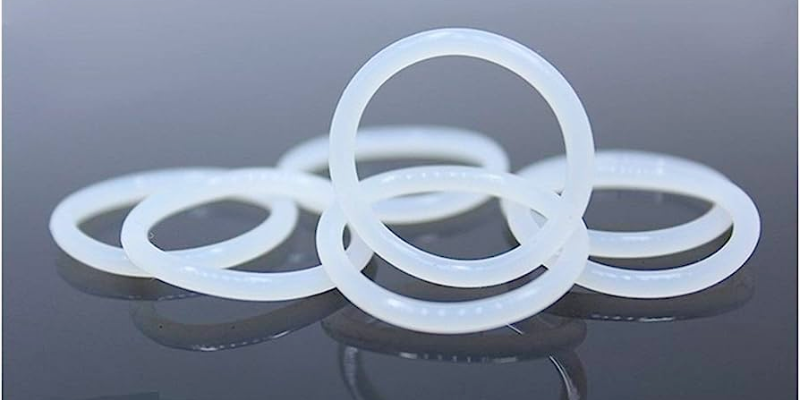But how do these two O-ring materials compare advantages and drawbacks? By understanding the differences between Viton and silicone rubber O-rings, you’ll be better equipped to make an informed decision for your specific needs.
What is Viton O-Ring?
Viton O-ring is made from a specialized fluoroelastomer material known as Viton. This synthetic rubber is derived from fluoropolymer elastomers and combines fluorine, carbon, and hydrogen atoms. The unique composition gives Viton its remarkable resilience and durability.
Characterized by their resistance to chemicals, heat, and extreme temperatures, Viton O-rings offer reliable sealing solutions in demanding applications. Here’s what you need to know about them:

- Chemical Resistance: One of the key advantages of the Viton O-ring is its excellent resistance to a wide range of chemicals. They can withstand exposure to aggressive substances such as fuels, oils, solvents, strong acids, and bases without deteriorating or losing their sealing capabilities.
- Heat Resistance: Another notable characteristic of Viton O-rings is their ability to withstand high temperatures. They can maintain their integrity even when exposed to extreme heat conditions up to 200°C (392°F) or higher. This makes them suitable for use in applications where other rubber materials would fail.
- Extreme Temperature Performance: In addition to heat resistance, the Viton O-ring also exhibits exceptional performance at low temperatures. They remain flexible and functional even in freezing environments, ensuring reliable sealing under diverse temperature conditions.

Due to these outstanding properties, Viton O-rings are extremely versatile, finding a home in many chemical processing, automotive, and appliance applications.
They have become indispensable components in critical systems across industries that require dependable sealing solutions.
Whether it’s automotive engines subjected to intense heat or oil & gas equipment exposed to higher temperatures and harsh chemicals, these O-rings play a vital role in maintaining operational efficiency and preventing leaks.
What is a Silicone Rubber O-Ring?

Silicone rubber O-ring is a type of sealing ring material, that possesses unique composition and properties.
Silicone O-rings are known for their excellent flexibility and low compression set, making them highly suitable for applications requiring low absorption and high sealing performance at lower temperatures.
The composition of silicone O-rings allows them to withstand a wide range of temperatures while maintaining their sealing capabilities. Here’s what you need to know about them:

- High-temperature resistance: Silicone O-rings can withstand temperatures up to 250°C (480°F), which makes them suitable for high-temperature applications.
- Excellent elasticity: The high elasticity of silicone O-rings allows them to withstand large amounts of stretching, making them suitable for applications requiring frequent maintenance.
- Excellent compression set: Silicone rubber O-rings have an excellent compression set, which means they can withstand large amounts of pressure without showing signs of permanent deformation.
- Excellent chemical resistance: Silicone rubber O-rings are resistant to a wide range of chemicals, making them suitable for use in applications requiring chemical resistance.
- Low-temperature performance: Silicone O-rings also perform well in low-temperature applications, as they can maintain their elasticity even in freezing conditions.
Due to their exceptional performance at lower temperatures, silicone rubber O-rings find extensive use in applications under extreme conditions such as refrigeration systems, HVAC units, and outdoor equipment exposed to colder climates.
They provide reliable sealing applications in these environments without compromising on durability or functionality.
Send Your Inquiry Now!
Quality Meets Affordability. Inquire Now for High-Quality Products at Low Volumes.
Comparison: Viton vs Silicone Rubber O-Rings
Viton, a type of fluoroelastomer, and silicone rubber O-rings are two commonly used materials for sealing and gaskets.
While both are well-suited to a wide range of applications, they have distinct advantages and disadvantages depending on the specific requirements of a given application.

| Properties | Viton O-Rings | Silicone Rubber O-Rings |
|---|---|---|
| Temperature Range | -20°C to 204°C (-4°F to 400°F) | -60°C to 232°C (-76°F to 450°F) |
| Chemical Resistance | Excellent | Good |
| Abrasion Resistance | Good | Good |
| Tensile Strength | Low | Medium |
| Resistance to Ozone | Excellent | Good |
| Cure Time | Short | Long |
| Cost | Higher | Lower |
Viton and silicone rubber o-rings are two different types of rubber materials used in various industrial applications here. Both materials have their properties and advantages, therefore it’s important to choose the right one depending on the application’s requirements.
Choosing Between Viton and Silicone Rubber for O-Rings
Manufacturers make O-rings and seals using various elastomers with different physical and chemical properties. When selecting the appropriate material for specific sealing applications, however, there are several factors to consider:
Compatibility with Media or Substances Being Sealed
One crucial aspect to keep in mind is the chemical compatibility of the rubber material with the media or substances that will be sealed. For instance:
- Viton rubber is known for its excellent resistance to a wide range of chemicals and fluids.
- Silicone rubber has good resistance to water, but it may not be suitable for certain aggressive chemicals.

Temperature Requirements
Another important consideration is the temperature requirements of your application. Different rubbers have varying capabilities in handling dry heat, hot water, and extreme temperatures:
- Viton rubber can withstand high temperatures up to 200°C (392°F), making it ideal for applications involving heat.
- Silicone rubber performs well across a broad temperature range, from -60°C (-76°F) up to 230°C (446°F).
Environmental Conditions
The environmental conditions under which your O-rings will operate should also be taken into account. Some points to consider are:
- Silicone rubber demonstrates good resistance to UV radiation and maintains its flexibility even in harsh outdoor environments.
Cost Considerations

Lastly, cost considerations play a significant role in material selection. While prices may vary depending on specific requirements and quantities needed:
- Viton rubber tends to be more expensive than silicone rubber due to its superior chemical resistance properties.
- Silicone rubber generally offers a more affordable option without compromising performance.
By carefully evaluating these factors – compatibility with media/substances being sealed, temperature requirements, environmental conditions, and cost considerations – you can make an informed decision when choosing between Viton and silicone rubber for your O-rings.
Send Your Inquiry Now!
Quality Meets Affordability. Inquire Now for High-Quality Products at Low Volumes.
Conclusion
In conclusion, both Viton and silicone rubber O-rings offer unique advantages and considerations for various applications.
When choosing between Viton and silicone rubber for O-ring material, it is crucial to consider factors such as the specific application requirements, operating conditions, compatibility with fluids or gases involved, and budgetary constraints.
Are You Looking for the Perfect O-rings? Hongju Can Help You
With Hongju Silicone‘s extensive knowledge and experience in custom O-rings, you can be assured that you’re getting only the best quality materials at competitive prices. Contact us today and learn more about O-ring material, and let us help you find the right o ring and the perfect solution for your application!